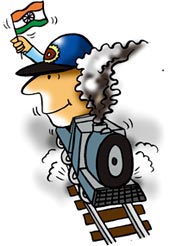Home > Cricket > World Cup 2003 > Diary
Batsman 1 to Bowler 6
Ashish Magotra in Pietermaritzburg |
February 05, 2003

Just 24 hours after landing in South Africa, I got to watch the Indians playing the first of their warm-up games, against KwaZulu Natal, at the City Oval in Pietermaritzburg.
Maritzburg, as the locals call it, has quite a history. It is one of the oldest grounds in South Africa, and the first match here was played way back in 1897. Rather intriguingly -- especially when you consider that two league games are scheduled to be played here, the main scorecard at the ground does not show you the names of the players. All you have is Batsman 1, Batsman 2 etc, followed by their scores -- which is pretty rudimentary.
The scoreboard may be prehistoric, but there is nothing wrong with drainage facilities here. Underground pipes have been laid every ten meters, to drain the ground. The water flows into these pipes and empties into a well at one end of the ground. The well, in turn, empties into the Msunduzi river.
'Msunduzi', in English, means bully.
 It is a pretty ground, surrounded by trees some of which have historical significance. There is a mahogany tree near the pavilion for instance that is almost 100 years old. It is a metre or more inside the playing area, and has tulips around its base. The rest of the trees in this area were chopped down, but this one survived because of its age.
It is a pretty ground, surrounded by trees some of which have historical significance. There is a mahogany tree near the pavilion for instance that is almost 100 years old. It is a metre or more inside the playing area, and has tulips around its base. The rest of the trees in this area were chopped down, but this one survived because of its age.
The ground authorities then ruled that even if the ball hit the tree on the full, at whatever height, the batsman was only entitled to a four. The question did not arise during Tuesday's (February 4) game, because the Indian batsman missed the tree altogether with their shots.
There is another tree in the vicinity that was planted by legendary England cricketer Denis Compton. And that reminds me of a small embarrassment -- I spent the day in the press box, and most of the morning I was chatting with this journalist, Patrick. During the lunch break, someone told me about this tree, and mentioned that Compton's son, a journalist, was present at the ground. His name, I was told, was 'Patrick'.
I went rushing back to the press box, buttonholed the guy I was chatting up all morning and asked him, your name is Patrick, right? Right, he says. "Patrick Compton?" I ask. Yes, he replies.
I'll have to remember to ask for surnames from here on.
Getting back to the trees at the ground, the likes of Jonty Rhodes, Jacques Kallis, Shivnaraine Chanderpaul have all contributed to the cause -- the unofficial rule here is that for every century or five-wicket haul in an international game, the concerned player plants a sapling, which bears his name.
 This is just one of the ways that Maritzburg celebrates cricketers. Two weeks ago, the authorities here unveiled a new weathervane -- in the shape of Jonty Rhodes effecting that famous diving run-out of Inzamam-ul Haq during the 1992 World Cup. South African cricket board chief Percy Sonn, World Cup 2003 chief Dr. Ali Bacher and Rhodes himself were present at the unveiling -- they were hoisted to the rooftop by a fire-engine.
This is just one of the ways that Maritzburg celebrates cricketers. Two weeks ago, the authorities here unveiled a new weathervane -- in the shape of Jonty Rhodes effecting that famous diving run-out of Inzamam-ul Haq during the 1992 World Cup. South African cricket board chief Percy Sonn, World Cup 2003 chief Dr. Ali Bacher and Rhodes himself were present at the unveiling -- they were hoisted to the rooftop by a fire-engine.
India's next warm-up match is at Chatsworth, some 20 minutes out of Durban -- a region that, locals say, has the highest concentration of Indians in South Africa. So Ganguly's boys will literally be playing "at home". Locals, in fact, proudly point out that Chatsworth now has a higher proportion of Indians to locals than England, which till recently topped the charts in this respect.
A story doing the rounds here is that Chatsworth wanted to host one of the World Cup games, but was refused the chance -- the organizers pointed out that three million rand (Rs 17.1 million approx) to upgrade the facilities, which the UCB said it could not spare.
As a mark of defiance, the locals put up the money themselves and upgraded the facilities, and now get to host 'their' team in a warm-up game.
Speaking of crowds, the game at Maritzburg was supposed to be a sell-out, but as one used to the crowds in India, I didn't think it was an impressive turn-out. The stands were mostly filled with school children, but the authorities told me they were impressed by the numbers, especially considering that Tuesday was a working day.
I was speaking to coach John Wright after the game yesterday, and he said that Sachin Tendulkar batting at three was no experiment -- he might even open the innings, Wright said, but is most likely to bat at number three in most of the games.
Overall, it was a pretty impressive batting performance by the Indians, on a pitch of uneven bounce where some deliveries bounced twice before the keeper got his hands on them, while others stood up from a length. Sourav Ganguly had a reasonably long outing -- he looked tentative to start with, but as time passed he seemed to find both his feet, and the fluency of his timing.
Tendulkar's innings was a study in patience and in waiting for the right ball to hit, but the knocks that captured attention were those of Rahul Dravid and Yuvraj Singh. In the press box, we would occasionally check with the scorer -- a 16-year-old girl who knows her figures -- and we would be told that Dravid was 40 off 46 deliveries, and we would have no idea how he got there because he never seemed to be doing anything special. The Indian vice-captain has become very good at working the ball around into the gaps -- I'd think his stint as wicketkeeper has really helped his batting; he gets to stand behind the sticks and watch the best batsmen in the business, in one-dayers, and it is evident that he has learnt from the experience.
Yuvraj's innings gave rise to the feeling that he could really be the star of this line-up -- his game seems suited for conditions here, he is a fluent puller of the ball and quick to pounce on anything short, he drives well on the up and revels in conditions where the ball is coming on to the bat. In his knock on Tuesday, he looked the most at home among the Indians.
The Indian bowlers didn't get a real work-out since the second innings lasted only 18 overs before a thunderstorm forced closure. Ashish Nehra and Ajit Agarkar both looked out of sorts initially, but once they worked out the right line and length to bowl, both steadied and had, in fact, looked to get the measure of the opposition when play was called off.
Digressing from the cricket, the roads here are superb -- and locals say that this is one of the more beneficial results of the apartheid regime. When anti-apartheid fervor was hotting up and the whites were preparing to crush the movement even at the expense of their own lives, the white-controlled South African army, to ensure rapid deployment, made sure the inter-connecting roads between cities were in top class condition.
The thing with travelling is how preconceptions change. For instance, what is the number one sport in South Africa? You would say cricket or rugby -- and a week ago I would have agreed with you. But surprise, surprise, it is neither -- the pride of place, if you look at the numbers watching and playing a sport, goes to football with cricket in second place and rugby a clear third.
It is among the whites that rugby rules, followed by cricket -- the colored population, which is numerically in a majority, prefers football as the sport of choice.
 Digressing again, the Indians will on February 21 take part in a ceremony commemorating Mahatma Gandhi's stay in this country, when from a small station near Durban they board an old-fashioned steam engine, which they will ride in till Maritzburg.
Digressing again, the Indians will on February 21 take part in a ceremony commemorating Mahatma Gandhi's stay in this country, when from a small station near Durban they board an old-fashioned steam engine, which they will ride in till Maritzburg.
The ceremonial ride recreates the one Gandhi took in South Africa during his years as a barrister, which saw him being ousted from the first class compartment on the grounds that it was reserved for whites.
When he refused to give up his seat, pointing out that he had a reserved ticket, he was thrown out at Maritzburb station -- which, the locals tell me, has remained largely unchanged in all these years except for several plaques at the entrance that commemorate an event that was to give birth to India's freedom struggle and, indirectly, to South Africa's struggle against apartheid as well.
I have a ticket for that ride, so I'll keep you posted on how that goes. Meanwhile, for today, it is over and out.
Illustration: Uttam Ghosh
Schedule | Interviews | Columns | Discussion Groups | News | Venues